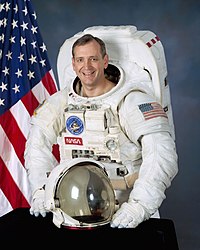Thomas Dale Akers
| Thomas Akers | |
|---|---|

|
|
| Country: | United States |
| Organization: | NASA |
| selected on | June 5, 1987 (12th NASA Group) |
| Calls: | 4 space flights |
| Start of the first space flight: |
October 6, 1990 |
| Landing of the last space flight: |
September 26, 1996 |
| Time in space: | 33d 22h 44min |
| EVA inserts: | 4th |
| EVA total duration: | 29h 40min |
| retired on | August 1997 |
| Space flights | |
Thomas Dale Akers , called "Tom" (born May 20, 1951 in St. Louis , Missouri , USA ) is a former American astronaut .
Youth and education
Akers grew up in the village of Eminence, which is 200 kilometers northeast of St. Louis. After high school, he studied applied mathematics at the University of Missouri . In 1973 he received a bachelor's degree and a master's two years later .
Astronaut activity
In 1990 Akers flew his first space flight with the STS-41 mission as a mission specialist. In 1992 he flew again as a mission specialist on his second space flight with the STS-49 mission . In the following flights (1993 STS-61 and 1996 STS-79 ) he performed the same function.
Flight with STS-41
The launch of STS-41 took place on October 6, 1990 at the Kennedy Space Center . The flight lasted 4 days, 2 hours and 10 minutes. Several smaller experiments were carried out and the Ulysses solar probe was exposed. The mission ended on October 10, 1990 with the landing at Edwards Air Force Base .
Flight with STS-49
The STS-49 mission started on May 7, 1992 . The take-off and landing locations were the same as Aker's first space flight. The aim of this mission was to capture the Intelsat VI-F3 communications satellite for repair. After two unsuccessful outboard activities (EVAs) by Pierre Thuot and Richard blow Akers was in the third and successful action there. The astronauts had to handcatch the satellite, after which it was fitted with a new apogee motor and placed in geostationary orbit . Akers carried out a second EVA with his colleague Kathryn Thornton to test structures and tools. The landing took place on May 16, 1992. Akers and the rest of the crew had been en route for 8 days, 21 hours and 17 minutes.
Flight with STS-61
On December 2, 1993, the STS-61 mission launched from the Kennedy Space Center. The aim of the mission was to capture and repair the Hubble Space Telescope (HST). Jeff Hoffman and Story Musgrave , Akers and his colleague Kathryn Thornton each undertook an exit into space for this purpose. The fourth EVA undertook again Akers and Thornton to replace an inferior photometer with a lens that should compensate for the enormous mirror error of the telescope. The fifth and final EVA was undertaken again by Hoffman and Musgrave, also with the task of performing an exchange. The solar cell surfaces were given a new electronic solar drive and a few magnometers, the protective covers of which had been made from residual material by colleagues from Akers, Nicollier and Bowersox . After the heavy repair was done, the HST could be exposed again. Akers' third mission ended on December 13, 1993.
Flight with STS-79
STS-79 launched on September 16, 1996 to the Mir space station from the Kennedy Space Center, where the mission later ended again. The space shuttle Atlantis was docked to the space station for four days. On this mission, the Mir crew member Shannon Lucid was replaced by John Blaha , who flew back with STS-81 . After the exchange of supplies and experiments, the mission returned to Earth on September 26, 1996. The flight lasted 10 days, 3 hours and 19 minutes.
He left the astronaut squad on August 1, 1997.
Private
Akers is married and has two children.
See also
Web links
supporting documents
- Short biography of Thomas Dale Akers at spacefacts.de
- NASA biography of Thomas Dale Akers (English; PDF)
- Biography of Thomas Dale Akers in the Encyclopedia Astronautica (English)
| personal data | |
|---|---|
| SURNAME | Akers, Thomas Dale |
| BRIEF DESCRIPTION | American astronaut |
| DATE OF BIRTH | May 20, 1951 |
| PLACE OF BIRTH | St. Louis , Missouri , USA |